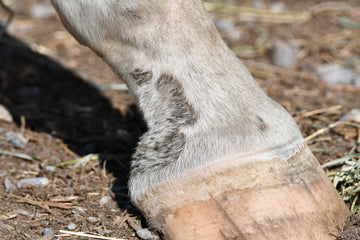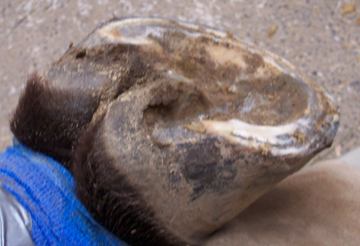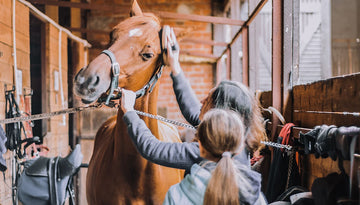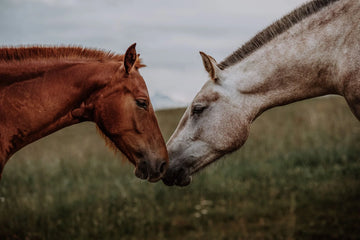
We’ve all heard the saying…”April showers bring May flowers!” If you are a horse owner, when you hear that saying, you can not help but think about how spring showers bring on skin problems! Aside from dealing with endless mud problems, the biggest issue equestrians deal with this time of year is rain rot! Rain rot is a bacterial infection of the skin that causes scabs and lesions. It is also called rain scald or dermatophilosis, and is a skin infection caused by a bacterium known as Dermatophilus congolensis. The most common way a horse ends up with rain rot is by being subjected to wet conditions for a long period of time. Living on the horse's skin, D. congolensis is mostly dormant, but under wet conditions, this bacterium can cause an inflammatory infection resulting in lesions along your horse's coat. The outer layer of your horse’s skin becomes soft and compromised when its skin remains wet for an extended period of time. Once this happens, the outermost layer of their skin begins to break down leading to cuts and other skin problems. The crusty scabs are not painful for your horse. Surprisingly, they have not been shown to cause itchiness either. But if they are rubbed against, the scabs can fall off, leaving pink, pussy skin unprotected where the scab was removed. Wet conditions are not the only way your horse can end up with rain rot. In fact, a weak immune system, poor nutrition, poor hygiene, and other stressful circumstances can heighten the risk of your horse contracting the disease. With more rain coming this spring and temperatures rising, this makes the perfect recipe for this annoying skin infection!
Typically when searching for rain rot, you will find it on your horse’s back, head, and neck, but it can really be on any part of their body. Unfortunately, some horse owners often mistake rain rot for fungal diseases such as ringworm which aren’t as common. When this happens, owners typically start with an antifungal medication that will not have any effect on the bacteria caused by rain rot. Identifying this condition is extremely important so that you can properly treat it and prevent it from spreading. If needed, it may be a good idea to consult with your vet! When diagnosing, in the early stages of infection, you will feel small lumps on your horse’s skin/hair by running your hand over their coat. As rain rot progresses, you'll see crusty scabs that expose smooth, bare skin when picked off. The lesions are oftentimes itchy or even painful. This fungus is extremely contagious and can be easily passed from horse to horse! This is why giving your horse its own set of brushes and washing them regularly is best. You also want to refrain from sharing blankets and tack too.


How do you prevent rain rot? The honest answer is we, unfortunately, can not control mother nature and there will still be rainy days, flooding, muddy pastures, etc so we can not 100% prevent it. Fortunately, we can stay proactive in minimizing the chance that they contract this fungus! As mentioned, do not share anything with other horses. That is the easiest way to spread it. Consistent grooming definitely helps, especially if it is paired with our Copper Curry horse brush and Matico Healing Spray! Copper contains natural antifungal and antimicrobial properties which allows our curry to be used without-cross contamination between horses! The Matico Spray acts as an antiseptic that treats wounds and discomforts. Grooming also helps keep their coat and skin healthy. It also allows you to keep an eye on their skin so you can spot conditions and treat them ASAP! Another great way to try to minimize rain rot and also treat it is by horse bathing! Our all-natural Matico Natural Healing Shampoo is formulated with the Matico plant. This plant is known to act as a natural antiseptic, anti-inflammatory, promote wound healing, and more. This must-have product should be in every barn because not only does it clean but also treat skin infections/soothes skin. After applying the horse shampoo, you want to leave it on for about five minutes so it can really soak in and heal your horse’s skin. Other ways you can help prevent rain rot is by making a habit of washing your horse’s tack and equipment thoroughly and frequently. Should they develop sores in the saddle area, try to give them a little time to heal because continuing to ride them can trap moisture against their skin and cause discomfort and fungi. Another important tip is that you should pat your horse’s body dry after a bath and keep them inside until their coat dries completely. You can prop a fan in front of them to help expedite the process. As mentioned in order for an infection to be established, there must be some break in the skin such as abrasion. This can include bug bites! So during the buggy season, consider spraying insect repellent on a regular basis.
If you are concerned that the infection may have become too advanced for at-home treatment, contact your Vet immediately. Although rain rot is a pain to deal with, it is treatable, provided you are diligent and proactive about treating the infected areas! By following along with the tips above, we hope to help you treat your horse from this annoying but curable infection! We hope these recommendations will help you as a horse owner and your horse welcome spring with open arms and hooves, and maybe even help get your horse’s coat show ring ready!










